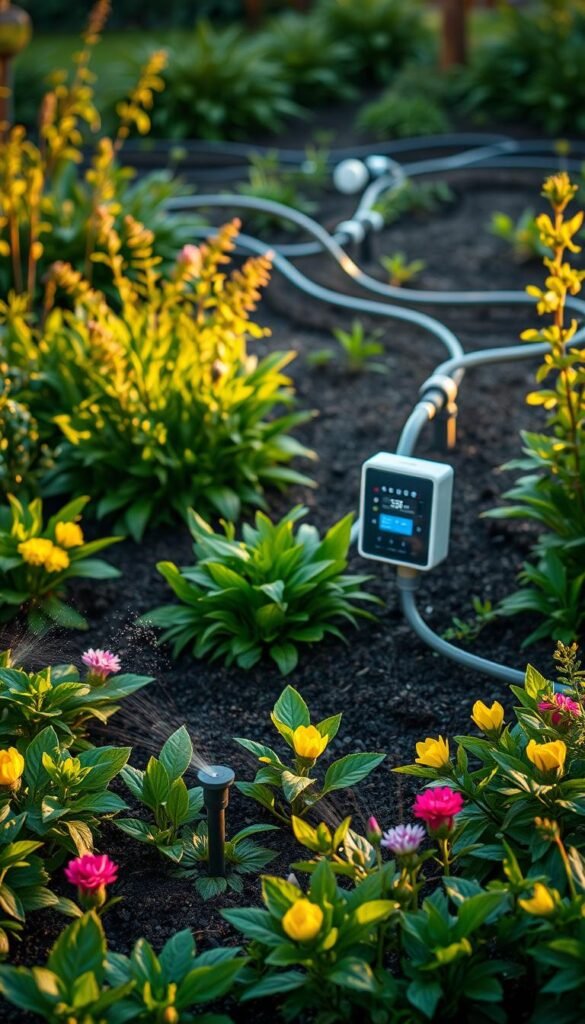Imagine never overwatering your plants again. Modern watering technology now lets you cut outdoor water use by up to 50% while keeping your landscape thriving. These advanced setups use real-time weather updates and soil data to deliver precise hydration exactly where nature needs it.
Picture this: sensors track ground moisture levels, while weather tech skips scheduled watering when rain’s coming. You save money, conserve resources, and give every flowerbed exactly what it craves. No more guessing games with sprinklers or wasting gallons on thirsty lawns.
Best part? You control everything from your phone. Adjust schedules during vacations or heatwaves without stepping outside. That’s the magic of blending nature with innovation – your green space stays lush while you reduce environmental impact.
Upfront costs might make you pause, but most users see returns within two seasons through lower bills and healthier plants. As droughts become more common, these tech-driven solutions aren’t just convenient – they’re essential for sustainable living.
Assessing Your Garden and Planning Your Irrigation Setup
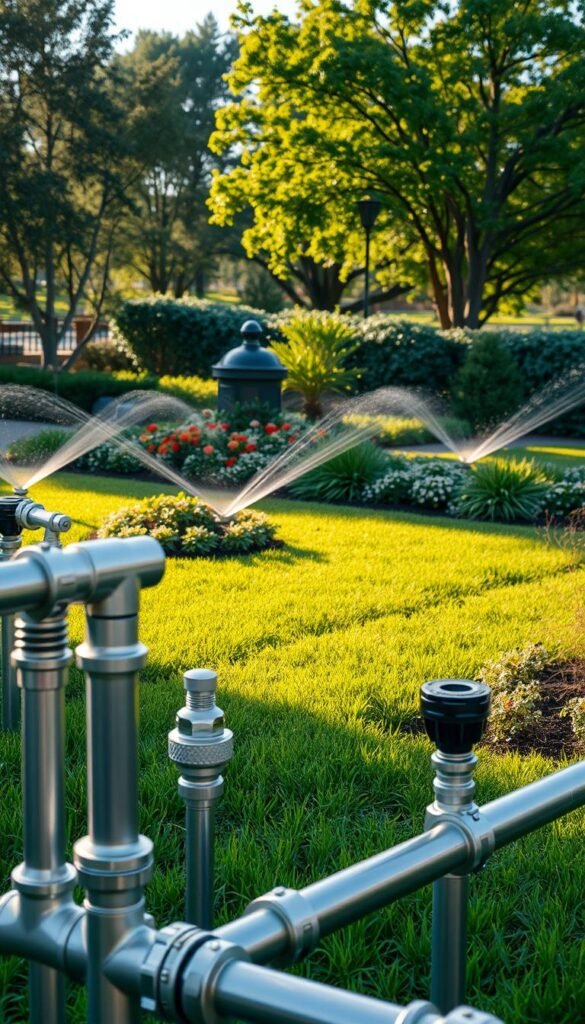
Unlock your landscape’s potential by mapping its natural water patterns. Your first task? Decode what’s happening underground. Soil acts like a sponge, but its absorption power depends on texture and structure.
Evaluating Soil Conditions and Water Needs
Dig into your soil’s secrets with a simple test. Sandy earth drains like a sieve, while clay holds moisture like a vault. Stick your finger 3 inches deep – if it feels dry, your plants need hydration. For precision, use a moisture meter to track real-time data.
Designing Efficient Hydrozones for Plant Groups
Group thirsty tomatoes with water-loving hostas, but keep lavender and sage separate. Create three zones:
- High-water areas: Vegetable patches and tropicals
- Moderate zones: Flowering shrubs and young trees
- Low-demand sections: Native grasses and succulents
Sun exposure and wind patterns matter too. South-facing slopes dry faster, while shaded valleys retain moisture. Improve water retention in sandy plots by mixing in compost – perfect for pairing with low-cost watering solutions.
By matching plants to their ideal zones, you’ll slash water use while boosting plant health. It’s like giving each green friend their personalized hydration plan!
Choosing the Ideal Smart Irrigation System
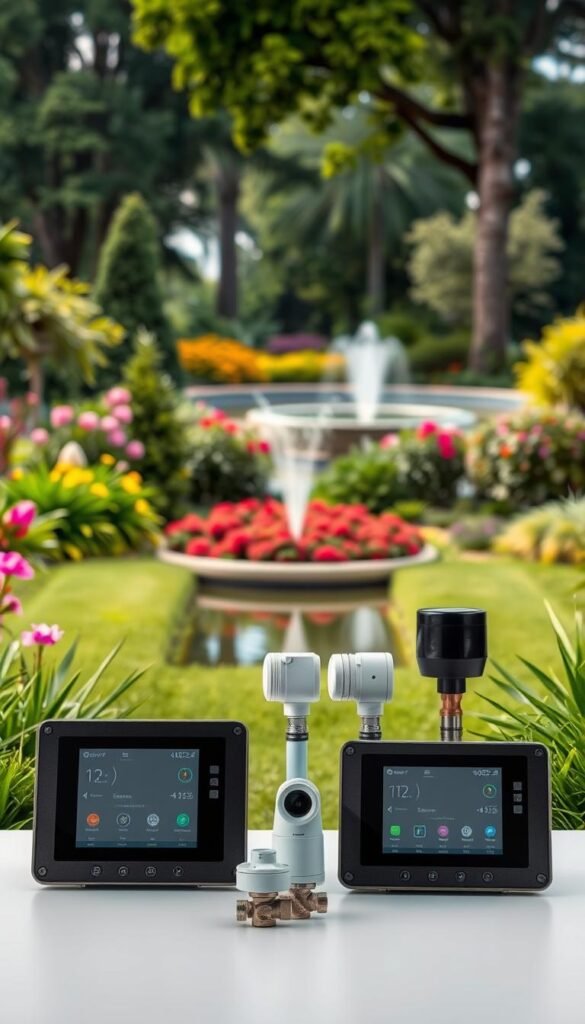
Upgrading to tech-driven watering solutions requires balancing needs and budget. Top brands like Rachio, Rain Bird, and Hunter dominate the market, each offering distinct smart irrigation systems with varying features and price points. Let’s simplify your decision-making process.
Brand Showdown: Capabilities That Matter
Rachio’s controllers shine with hyper-local weather tracking and smart irrigation system integrations. Rain Bird excels in durability, while Hunter offers robust multi-zone support. Key differentiators:
- Soil sensors accuracy (critical for clay soils)
- App interface intuitiveness
- Compatibility with other technology like Alexa
Smart Spending: Costs vs. Long-Term Gains
Basic setups start around $200, while whole-property systems reach $2,500+. Consider these factors:
- Installation complexity (DIY vs professional)
- Water bill reduction potential
- Scalability for future warm climate adaptations
Prioritize features matching your property size. Small gardens thrive with simple timer upgrades, while acreages need advanced analytics. Remember – the right system pays for itself through healthier plants and lower water usage.
Incorporating Smart Irrigation Systems into Your Garden Design Layout
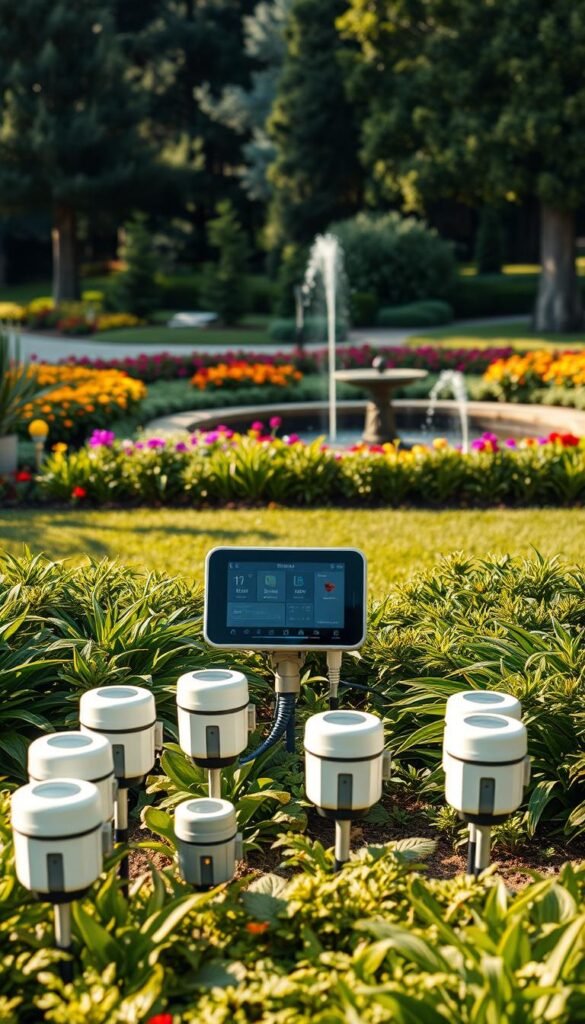
Transform your watering routine with precision tools that listen to nature’s cues. Modern sensors and apps work together to create responsive hydration networks tailored to your landscape’s unique needs.
Sensor Installation Made Simple
Weather trackers mount on fences or poles where they get clear sky views. These devices sync with local forecasts, automatically adjust watering schedules before storms arrive. For soil analysis, bury moisture sensors 6-8 inches deep in plant root zones – the sweet spot for accurate readings.
Create a sensor network by placing devices in different hydrozones. Sandy areas need more frequent checks than clay sections. Use this table to optimize placement:
| Sensor Type | Placement Depth | Data Frequency | Best For |
|---|---|---|---|
| Soil Probe | 6-8″ | Hourly | Vegetable beds |
| Surface Sensor | 1-2″ | Daily | Lawns |
| Weather Station | 5-7′ high | Real-time | Entire property |
App Control Mastery
Connect all devices through your phone using the manufacturer’s app. Set custom rules like “Skip watering if soil moisture exceeds 40%.” Receive alerts for leaks or frozen pipes during cold snaps.
Advanced systems let you create zone-specific parameters. Pair this with smart watering techniques for container plants to complete your water-efficient setup. Most apps show weekly water savings – perfect for tracking eco-impact.
Finalize your installation with backflow preventers on faucet connections. Use pressure regulators to protect emitters in delicate flower beds. Within hours, you’ll have a self-regulating system that combats overwatering while keeping plants thriving.
Maintenance and Optimization for Long-Term Efficiency
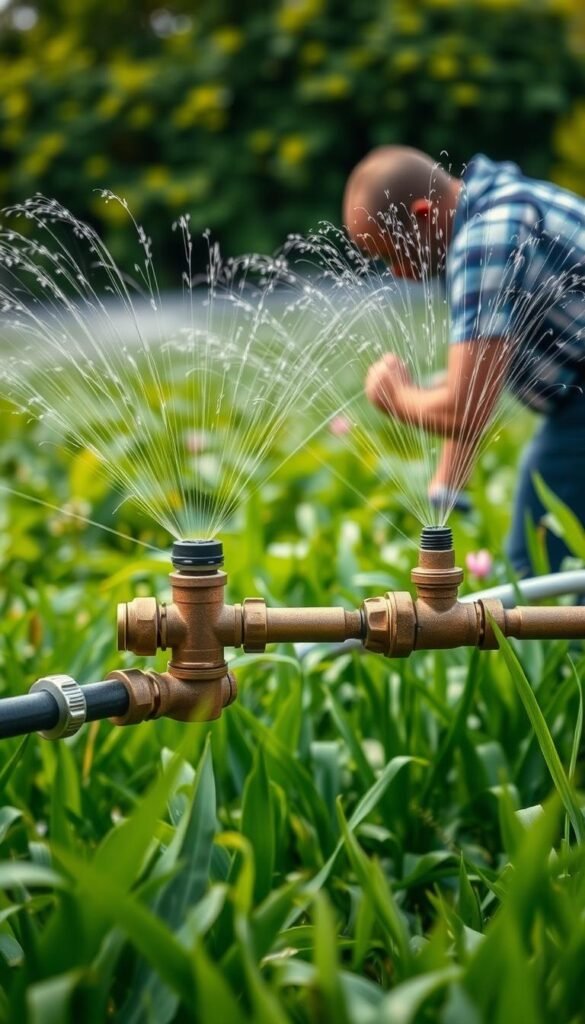
Keep your garden thriving year-round with simple upkeep steps. Regular care ensures your setup stays efficient while protecting your investment. Think of it like changing your car’s oil – small efforts prevent big headaches later.
Regular Testing, Calibration, and Troubleshooting
Run full system checks monthly. Look for cracked spray heads, blocked drip lines, or misaligned sprinklers. Test each zone separately – dry spots often mean clogged filters. Clean sensors with a soft brush to maintain accurate soil readings.
Calibrate devices seasonally. Increase watering time during summer heat, then reduce it in fall. Most apps let you adjust watering schedules in three clicks. Winterizing matters too: drain pipes before frost and store above-ground components.
Leveraging Data to Adjust Watering Schedules and Save Costs
Your system’s reports reveal hidden patterns. Notice ferns getting too much water? Cut their zone’s runtime by 20%. Track weekly water savings against past bills – many users save 30-40% annually.
Sync weather forecasts with your app for automatic rain delays. Pair this data with a square foot garden layout for precision hydration. Over time, you’ll spot trends like thirsty shrubs or efficient native plants.
Remember: healthy roots need oxygen too. Let soil dry slightly between cycles to prevent overwatering. With smart tweaks, your garden becomes a self-regulating ecosystem that thrives with minimal input.
Wrapping Up Your Smart Garden Journey
Your garden’s transformation into a water-wise paradise starts here. These technology-driven solutions do more than save time – they protect our planet’s most vital resource. With systems adapting to weather patterns and soil needs, you’ll nurture thriving plants while cutting water waste by up to 50%.
Think long-term: the initial investment pays off through lower bills and lush growth. Your landscape becomes climate-resilient, bouncing back from droughts and heatwaves. Even small spaces benefit – pair these setups with container gardens for maximum efficiency.
Every drop saved strengthens local ecosystems and sets an example for neighbors. New features like AI adjustments and ultra-precise sensors keep improving, making water conservation easier than ever. Your choices today create greener tomorrows – one smartly watered plant at a time.
Ready to make every watering count? Start small, track your savings, and watch your garden flourish with purpose. The future of gardening grows brighter – and drier – thanks to these innovations.

